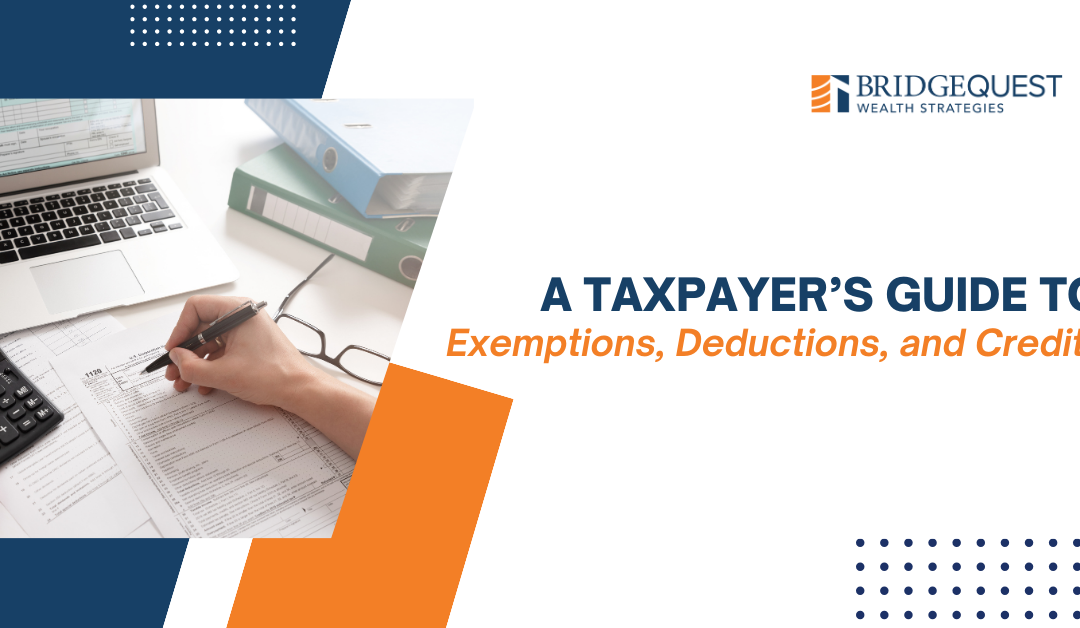When filing your income taxes, each taxpayer is different. Some prefer reducing the taxes they owe and getting the most significant possible refund, while others work to keep the taxes they pay as low as legally required. The IRS provides a few ways taxpayers can reduce the taxes they owe if they qualify for certain exemptions, deductions, and credits. Let’s take a closer look at what these are and how they could impact your tax return.
Tax deductions – Tax deductions reduce your taxable income, potentially lowering the taxes you owe. A few examples include:
· Medical expenses
· Property taxes
· Charitable contributions
· Mortgage interest
· State taxes paid
· Student loan interest
Tax exemption – Tax exemptions include income or transactions that are free from tax at the federal, state, or local level. These include:
· Some non-profits
· Specific veteran (for example, disabled veterans) and veterans’ organizations
· Income from some types of investments like municipal bonds.
Tax credit – A tax credit is a provision that helps to lower a taxpayer’s tax bill dollar-for-dollar. This differs from tax exemptions and deductions, which reduce taxable income as opposed to the tax bill directly. Tax credits are broken up into refundable and nonrefundable credits.
· Refundable credits
These tax credits are “refundable” because if you qualify for the credit and the amount is larger than the tax you owe, you can get a refund for the difference. Examples of refundable credits include:
o Earned income tax credit
o Additional child tax credit
In some cases, even if you don’t owe any tax, you may still be eligible for a refund. A financial professional can help you learn if any of these credits apply to you. For example, you wouldn’t owe federal income taxes if you earned less than the standard deduction.
· Nonrefundable credits
Not all tax credits are refundable. When dealing with nonrefundable tax credits, once taxpayers’ liability is zero, they won’t receive any refund from leftover amounts. Examples of nonrefundable tax credits include:
o Saver’s credit
o Adoption credit
o Foreign tax credit
o Residential energy efficient property credit
o Lifetime learning credit
o Credit for the elderly or the disabled
o General business credit
o Alternative motor vehicle credit
Many tax credits and types are available, and the amounts vary per tax year. All tax credits have qualifications the taxpayer must meet to receive the credit. These requirements may include:
· Family size
· Income level within a specified range
· Taxpayer must have had some earned income
When preparing your federal tax return, research current tax credits and determine eligibility. It might help to seek the assistance of a financial professional.
Get the help you need
Since taxes can be complicated and your decisions impact your income tax return and financial goals, scheduling a meeting to consult your financial professional may be beneficial. They might have insight and strategies you have yet to think about that could help you make your money work for you and save on taxes.
Important Disclosures:
The opinions voiced in this material are for general information only and are not intended to provide specific advice or recommendations for any individual.
This information is not intended to be a substitute for specific individualized tax advice. We suggest that you discuss your specific tax issues with a qualified tax advisor.
All information is believed to be from reliable sources; however, LPL Financial makes no representation as to its completeness or accuracy.
Sources: Nonrefundable Tax Credit: Definition, How It Works, and Benefits (investopedia.com) 5 Things You Should Know about Refundable Tax Credits – TurboTax Tax Tips & Videos (intuit.com) Refundable Credit: What it is, How it Works (investopedia.com) More than 40% of U.S. households will owe no federal income tax for 2022 (cnbc.com)
This article was prepared by LPL Marketing Solutions

